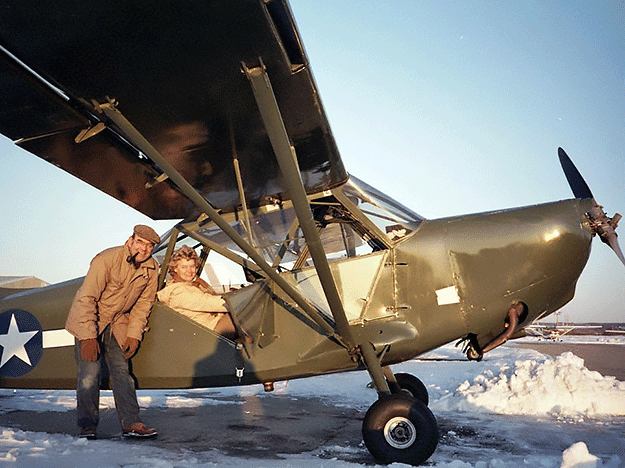In each issue of LIFT, we use the History of Hope feature to share a little about the individuals who have been formative in the history and growth of Wings of Hope.
After her dad passed away in 2014, Sue Miller said Wings of Hope founder Bill Edwards told her that her father, Capt. Clarence “Clancy” Hess, was a pioneer in the early days of Wings of Hope.
Sue says her dad’s involvement with Wings of Hope began soon after the organization was founded in 1963 and continued until about 2004.
“He was a pilot for American Airlines, and he was staying over in St. Louis and went to a rotary club meeting,” she recalls. “There was somebody from Wings of Hope giving a talk, and that’s when he got started.”
A lifelong aviator who began flying as a young boy, Clancy flew torpedo bombers in World War II and was an American Airlines captain from 1951-1981, except for the two years when he served in the Korean War. He was also an unsung hero to Wings of Hope.
“What my dad did for Wings of Hope is anytime somebody donated an airplane, he would go out there and fly it back to Lewis University, and the students would fix the airplane,” says Sue.
The Hess family lived close to Lewis University in Romeoville, Ill., which has an aviation school where students train to become licensed airframe and powerplant (A&P) mechanics.
“Sometimes, these planes weren’t in very good working order, but my dad was a good pilot — so if he could fly it, he would fly it.”
Once the plane was airworthy, Clancy would fly it to Wings of Hope’s hangar in St. Louis where the organization would use it for flying humanitarian missions or sell it to raise funds.
Clancy, who spent years on the Wings of Hope Board of Directors, also tirelessly spread the word about Wings of Hope.
“Every time he went on his flights working for American Airlines, he had his briefcase with him filled with all the Wings of Hope literature,” Sue recalls. “He would just talk to everybody, everywhere about Wings of Hope. When you talk to so many people, somebody’s going to chip in.”
Sue’s older sister, Kathy Kallai, was 10 when her dad started volunteering with Wings of Hope.
“Wings of Hope and what he was doing was always in the background for me,” she says.
The sisters say supporting their dad’s work with Wings of Hope was a family affair, with mom, Kay, leading the way and including brothers John, Bob, Greg and Jim.
John recalls his dad picking up a World War II-era Stinson L-5 Sentinel in California to fly back to Lewis University — and worrying about his father flying the long trip to Illinois solo.
“I watched him take off with a snowmobile suit on and handheld radio,” says John. “I just stood there for about 20 minutes until it was out of sight — just stood there looking at the dot disappear.”
Kathy has vivid memories of watching her dad take off from Lewis University in the planes the students had worked on for Wings of Hope.
“I just remember watching him fly away from Lewis and thinking, ‘I hope he gets there.’ But they were in much better shape when he left with them,” Kathy says.
When asked what Wings of Hope meant to her father, Kathy says, “it was a huge thing for my dad.”
“He absolutely loved it — thrived on it.”
In a Chicago Sun-Times article dated June 18, 1979, Clancy called Wings of Hope his full-time avocation.
“Other people spend a lot of time bowling or playing golf,” he said. “But I like to help people help themselves.”
Kathy says she believes her dad was drawn to Wings of Hope both because of his love for aviation and his desire to help people.
“You put those two things together — the help for people who need help and the airplanes — and it was just a good match.”
Sue was born in 1963, the same year Wings of Hope was founded. The youngest of six, she has spent the years since her father’s death sorting through boxes and boxes of materials her dad stored in the basement of her childhood home in Lockport, Ill.
“He kept everything,” she says.
“Everything” includes all correspondence, promotional materials, news articles and photographs related to Clancy’s involvement with Wings of Hope.
“I couldn’t just throw it out,” says Sue. “My whole life was my dad serving Wings of Hope. It was just part of him.”
Since she didn’t know what was important, she decided to archive all of it.
“I took everything Wings of Hope, and I organized it by date from the late 1960s probably up to the early 2000s,” she says. “I just put it in order, and I started scanning it all.”
Sue has shared everything she has scanned, as well as binders of printed materials, with Wings of Hope — providing a tremendous service in preserving a key part of the organization’s history.
Both sisters talk nostalgically of their dad’s service to Wings of Hope.
“I am so proud of him, for his commitment to it all,” says Kathy.

